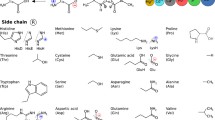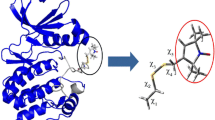Summary
Applying the semiempirical MO methods AM1 and PM3 as well as the density functional theory to the model of the catalytic site composed of ca. 160–190 atoms, we have carried out studies aimed at the explanation of three aspects of the mechanism of action of aspartic proteinases: the site of dissociation within the catalytic diad COOH/COO- (i) in the free enzyme and (ii) in the Michaelis complex, and (iii) the energy changes associated with the catalytic paths. We have found that the state of dissociation within the catalytic diad is ligand-sensitive. In the free enzyme and in the intermediate complexes, Asp33 prefers to be dissociated with the outer oxygen of Asp213 protonated, while in the Michaelis and product complexes the opposite holds true. This is in agreement with recent mechanistic hypotheses and with some experimental results by FTIR and NMR. The energy diagram for the catalysis indicates that electronic effects are responsible most of all for the relative reduction of energy of the intermediates and possibly transition states on the catalytic reaction path. The shape of the diagram qualitatively agrees with the transition-state analogue theory for the enzymatic reactions.
Similar content being viewed by others
References
Ratner, L., Haseltine, W., Pataraca, R., Livak, K.J., Starcich, B., Josephs, S.F., Doran, E.R., Rafalski, J.A., Whitchorn, E.A., Baumaister, K., Ivanoff, L., Patteway, S.R., Pearson, M.L., Lautenberger, L.A., Papas, T.S., Ghrayeb, J., Chang, N.T., Gallo, R.C. and Wong-Staal, F., Nature, 313 (1985) 277.
Kestler, H., Kodama, T., Ringler, D., Marthans, M., Pedersen, N., Lackner, A., Regier, D., Sehgal, P., Daniel, M., King, N. and Desrosiers, R., Science, 248 (1990) 1109.
Fitzgerald, P.M.D. and Springer, J.P., Annu. Rev. Biophys. Biophys. Chem., 20 (1991) 299.
Oldziel, S., Ph.D. Thesis, University of Gdańsk, Gdańsk, Roland, 1995.
Sielecki, A.R., Hayakawa, K., Fujinaga, M., Murphy, M.E.R., Faser, M., Muri, A.K., Carilli, C.T., Lewicki, J.A., Baxter, J.D. and James, M.N.G., Science, 243 (1989) 1346.
James, M.N.G. and Sielecki, A.R., In Jurnak, J. and McPherson, A. (Eds.) Biological Macromolecule and Assemblies, Wiley, New York, NY, U.S.A., 1987, pp. 413–482.
Pearl, L.H., FEBS Lett., 214 (1987) 8.
Fruton, J.S., In Neuberger, A. and Brocklehurst, K. (Eds.) Hydrolytic Enzymes, Elsevier, Amsterdam, The Netherlands, 1987, pp. 1–38.
Kostka, V. (Ed.) Aspartic Proteinases and their Inhibitors, Walter de Gruyter, Berlin, Germany, 1985, pp. 1–110.
James, M.N.G. and Sielecki, A.R., Biochemistry, 24 (1985) 3701.
James, M.N.G., Sielecki, A.R., Hayakawa, K. and Gelb, M.H., Biochemistry, 31 (1992) 3872.
Veerapandian, B., Cooper, J.B., Sali, A., Blundell, T.L., Rosati, R.L., Dominy, B.W., Damon, D.B. and Hoover, D.J., Protein Sci., 1 (1992) 322.
Parris, K.D., Hoover, D.J., Damon, D.B. and Davies, D.R., Biochemistry, 21 (1992) 8125.
Hyland, L.J., Tomaszek, T.A., Roberts, G.D., Carr, S.A., Magaard, V.W., Bryan, H.L., Fakhoury, S.A., Moore, M.L., Minnich, M.D., Culp, J.S., DesJarlais, R.L. and Meek, T.D., Biochemistry, 30 (1991) 8441.
Hyland, L.J., Tomaszek, T.A. and Meek, T.D., Biochemistry, 30 (1991) 8454.
MOPAC 6.01, Unichem 2.1, Cray Research, Engano, MN, U.S.A., 1993.
Dewar, M.J.S., Zoebisch, E.G., Healy, E.F. and Stewart, J.J.P., J. Am. Chem. Soc., 107 (1985) 3902.
Stewart, J.J.P., J. Comput. Chem., 10 (1989) 209.
DMOL, v. 2.30, Biosym Technologies, San Diego, CA, U.S.A., 1994.
vonBarth, U. and Heidin, L., J. Phys. Chem. 5 (1972) 1627.
PCMODEL, v. 4.0, Serena Software, Bloomington, IN, U.S.A., 1991.
Gajewski, J.J., Gilbert, K.E. and McKevey, J., In Advances in Molecular Modeling, A Research Annual, Vol. 2, Jai Press, Greenwich, U.K., 1990.
James, M.N.G. and Sielecki, A.R., J. Mol. Biol., 163 (1983) 299, PDB file 3APP.
Iliadis, G., Zundel, G. and Brzeziński, B., FEBS Lett., 325 (1994) 315.
Goldblum, A., Glick, M. and Rayan, A., Theor. Chim. Acta, 85 (1993) 231.
Clarkowski, J., Oldziej, S. and Liwo, A., Pol. J. Chem., 68 (1994) 939.
Lienhard, G.E., Science, 180 (1973) 149.
Rich, D.H., J. Med. Chem., 28 (1995) 263.
Pauling, L., Chem. Eng. News, 24 (1946) 1375.
Goldblum, A., 2nd Israell-Polish Symposium on Chemistry and Biology of Peptides, Abstract Book, 1995, p. 23.
Suguna, K., Bott, R.R., Padlan, E.A., Subramanian, E., Scheriff, S., Cohen, G.E. and Davies, D.R., J. Mol. Biol., 196 (1987) 877.
Author information
Authors and Affiliations
Rights and permissions
About this article
Cite this article
Oldziej, S., Ciarkowski, J. Mechanism of action of aspartic proteinases: Application of transition-state analogue theory. J Computer-Aided Mol Des 10, 583–588 (1996). https://doi.org/10.1007/BF00134181
Received:
Accepted:
Issue Date:
DOI: https://doi.org/10.1007/BF00134181




